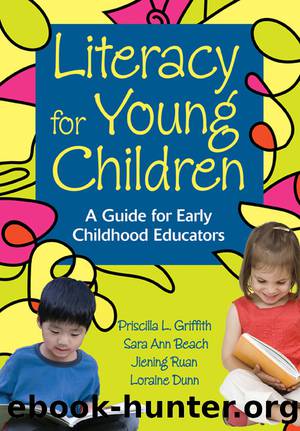Literacy for Young Children by Griffith Priscilla L.;Beach Sara Ann;Ruan Jiening;Dunn A. Loraine;

Author:Griffith, Priscilla L.;Beach, Sara Ann;Ruan, Jiening;Dunn, A. Loraine; [Griffith, Priscilla L.]
Language: eng
Format: epub
ISBN: 1650905
Publisher: Corwin Press
Published: 2008-03-07T00:00:00+00:00
A key part of comprehension is the background knowledge and experiences that a reader has.
A second type of database entry is those that represent familiar events. These entries include who might participate in the event, what happens during the event, and how the different aspects of the event fit together. For example, someone who lives near the ocean might have a database entry for going to the beach. That entry might include grandparents picking up the family, all of whom are wearing swimming suits and carrying towels, and driving to the ocean. At the seaside, the children take out plastic pails and shovels and run along the sand while the adults set up an umbrella and lay out towels. Then the children build structures out of the sand and play at the edge of the water where the waves come into shore. If a reader has this entry in her database when she reads a story about going to the beach, she will be able to activate that knowledge, visualize what is happening, and make connections, predictions, and inferences about what is happening. If a reader does not have this experience in her database, the story she is reading will be much more difficult to understand.
A third type of entry in the database is especially important to comprehending different types of texts a reader encounters. This type of entry represents the different ways that texts she has encountered in her world can be organized (see Figure 6.3). Stories have a particular organization that includes characters, a setting, a problem, a series of plot events, and a resolution. Informational books have several different ways that they can be organized that are different than stories (Vukelich, Evans, & Albertson, 2003). One way is where the books describe a concept or idea. Another way is to list events in sequence, or tell how something happened. A third way is to compare and contrast two or more concepts, events, or procedures, noting similarities and differences. A text might present a cause and discuss the effect of that cause, telling why something happened, or present a problem and outline the solution. Finally, informational text can make a statement about an event or an idea and then give reasons for that statement and examples to support those reasons. There are also other texts that readers encounter in everyday life that are organized differently from stories and informational books. These types of text include poetry they read in books or sing as songs, lists, letters and cards, menus, food boxes and cans, billboards and signs, newspapers and newsletters, telephone books, and grocery ads, to name but a few. Each of these types of text is organized in specific ways that indicate its purpose.
Download
This site does not store any files on its server. We only index and link to content provided by other sites. Please contact the content providers to delete copyright contents if any and email us, we'll remove relevant links or contents immediately.
Cecilia; Or, Memoirs of an Heiress — Volume 1 by Fanny Burney(31351)
Cecilia; Or, Memoirs of an Heiress — Volume 3 by Fanny Burney(30949)
Cecilia; Or, Memoirs of an Heiress — Volume 2 by Fanny Burney(30907)
The Lost Art of Listening by Michael P. Nichols(6484)
We Need to Talk by Celeste Headlee(4881)
Asking the Right Questions: A Guide to Critical Thinking by M. Neil Browne & Stuart M. Keeley(4599)
On Writing A Memoir of the Craft by Stephen King(4221)
Dialogue by Robert McKee(3593)
I Have Something to Say: Mastering the Art of Public Speaking in an Age of Disconnection by John Bowe(3520)
Pre-Suasion: A Revolutionary Way to Influence and Persuade by Robert Cialdini(3422)
Elements of Style 2017 by Richard De A'Morelli(2946)
The Book of Human Emotions by Tiffany Watt Smith(2779)
Good Humor, Bad Taste: A Sociology of the Joke by Kuipers Giselinde(2559)
Name Book, The: Over 10,000 Names--Their Meanings, Origins, and Spiritual Significance by Astoria Dorothy(2498)
Fluent Forever: How to Learn Any Language Fast and Never Forget It by Gabriel Wyner(2451)
The Grammaring Guide to English Grammar with Exercises by Péter Simon(2397)
Why I Write by George Orwell(2362)
The Art Of Deception by Kevin Mitnick(2303)
Don't Sleep, There Are Snakes by Daniel L. Everett(2220)
